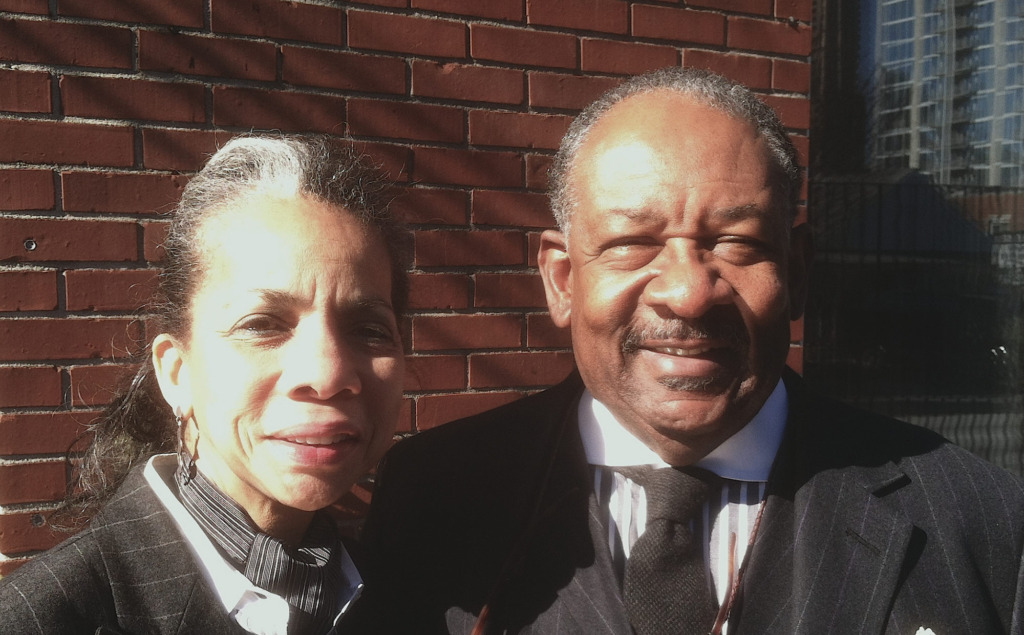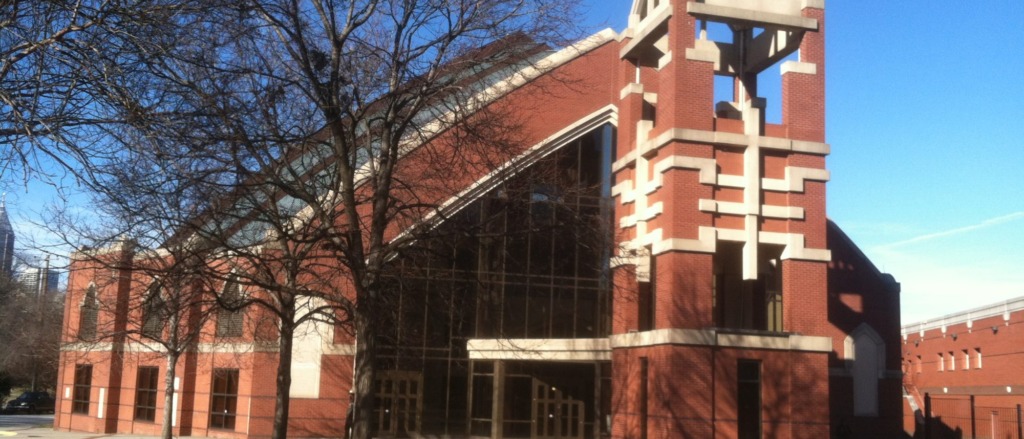Each submission gets timestamped with EST time and gets a unique identifier
assigned, example:
S10056


The Atlanta-based practice of architects William J. Stanley and Ivenue Love-Stanley, Stanley, Love-Stanley, has been one of inclusiveness, hospitality, and connection to place. This is especially true of their work with faith communities, which is how their practice started more than 40 years ago. Both have been recognized for their leadership in the profession; among their many honors they are both winners of the Whitney M. Young Jr. Award from the American Institute of Architects for the social import of their work. In this interview, they talk about their architectural practice as a form of ministry.
MJC: Micheal J. Crosbie
WJS: William J. Stanley
IL-S: Ivenue Love-Stanley
WJS: A little bit on our background: Ivenue’s family were committed members of the church. They spent a lot of time at church, they lived right around the corner. Ivenue’s two older sisters married pastors. My family is fifth-generation African Methodist Episcopal. When I was a kid, our congregation was building a new church. I would sneak down to the construction site during service, climb the fence, explore the construction and pore over the drawings, then sneak back to service. My aunt was president of the Women’s Auxiliary of the National Baptist Convention.
Ivenue and I had the same backgrounds: church, Sunday school, mandatory choir memberships. For a while I drifted away, studied Islam as part of my exploration as a young man. I came back to my church after meeting Ivenue. My cousin, Nelson Harris, was a church architect and one of the founders of the National Organization of Minority of Architects, so he was influential and a role model for me. His daughter Gail Harris was the second woman in the U.S. to become an Episcopal bishop.
IL-S: A lot of what we do today has to do with our backgrounds and the influence of the church. One of the first projects that Bill and I worked on together was St. Michael’s Catholic Church in Gainesville, Georgia, by Welton Becket. I was still in architecture school, and Bill was an intern architect. One of the principals at Becket gave us the schematics and asked us to finish it.
WJS: Some churches have a real sense of history, a sense of purpose, and they want to expand where they are, and that flows and drives the conversation. Others are aspirational churches. They have moved from somewhere else, and they need to respond to the new opportunities that they have. They may not have anchor churches around them. We really try to dig down and listen, sketching as we work with them. Once we understand their history and background, it helps form the design. For example, we were called upon to create the Lyke House Catholic Student Center on the Atlanta University Center campus; and the priest and committee we worked with incorporated a lot of Coptic art and images as part of their tradition. So we looked to the monolithic rock-carved churches at Lalibela in Ethiopia for inspiration. That connection resulted in a poured-concrete building, rusticated with bush hammering, with the windows formed like those on the Church of Saint George. We designed all the furniture as well, coordinated with the architecture.
IL-S: We try to understand the particular culture of every church we work with. We worship with them, we do the background research, understand their history, how they came about, what’s important to them. And for every house of worship we’ve done, we could go back to that congregation and join as full members, feel at home, and be welcome.
WJS: We also talk to not just the building committee members, but the people in the background: the ladies working in the kitchen, the guy parking the cars. We try to understand the congregation in its entirety.
IL-S: We really live with them. I think we come across as being not just an architectural firm, but part of their inner circle. I don’t think we would have been as successful with this approach if we had not been active in church ourselves.
WJL: We don’t approach design as an academic exercise. It helps that we know the hymns, the liturgy. We both have done independent Bible study and taught Sunday school. You need to look at how they use their space, the importance of meeting and fellowship before and after the service, what they do outside of worship. They might have daylong events, things like incantation dance, education, foodservice, and childcare—all those are bedrock to the success of the church. The places where you have a lot of activities, such as a gym or where the elderly hang out, is part of that success. Churches can really be enclaves that have linkages to other resources in the community: the library, or senior housing, or a school. That’s a key part of their success.
IL-S: How you define a house of worship is not just coming in on a Sunday for communion and prayer and hearing the word, and then you’re gone. It has to do with inclusiveness. There is something for everyone.
WJL: It’s important to connect the church back with the community. We’ve never done a “black box” church, where there are screens and no connection to the outside. We design with nature, preferring to see the trees’ seasonal changes, the occasional flash of lightning. The New Horizon Sanctuary at Ebenezer Baptist Church in Atlanta is a very Afrocentric building. They wanted stained-glass windows, which would tell the history of the diaspora from Africa, the slave trade, through to the civil rights movement; they even conducted a competition for the designs. We designed the window openings to receive those stained-glass windows. In the end, they just couldn’t afford them for the first phase. But what the congregation sees now is the city, the skyline, the community beyond the church. And people can see in. The church is connected to the community, and the community is connected back. They are inclusive in every way.
WJS: For just about any project an architect designs and builds, two things will very likely happen: the building will be transformed, find a second or third use, and, eventually, it will be torn down. With religious buildings, this is rarely the case. Most of our religious work has been done with African-American communities. They will build a school and a church, which they will always point to as symbols of their community. That is a huge joy for us as architects. It is such a great feeling: to design places that have been successful, where the church buildings work well, all while they are aging gracefully. That’s why for most of our churches we choose materials—stone, brick—that have a great sense of permanence.
IL-S: In terms of masonry or concrete construction, it’s important for a congregation to feel that this is a one-time investment. It has to do with what will be lasting and work best for the church.
WJS: It is. Do I pray about projects? Yes. Do I pray especially hard about our church projects? Absolutely. You pray that you don’t miss your calling with them. You can become so involved with your ego and be so stiff and ornery about driving home a point, that you miss the blessing and meaning of approaching the problem another way. You can miss what God might be trying to tell you. Sometimes you have to wait for an answer to come, at its appointed time.
IL-S: Our religious architecture is very much about who we are and what we do. I think we were meant to do it, in terms of the ways we work with the congregations. It boils down to the trust level. Ministries happen in different ways. For us, it has a lot to do with the faith that we have. Maybe this work is ordained. We may have been predestined to bring life to the community of faith.

Feature image: The exterior form of New Horizon Sanctuary of Ebenezer Baptist Church in Atlanta was inspired by African sculpted mounds. Photo courtesy of the architects.
Michael J. Crosbie is a Connecticut-based architect and writer who teaches at the University of Hartford and is Association of Collegiate Schools of Architecture Distinguished Professor. The author of and contributor to some four-score books, he studied architecture at The Catholic University of America in Washington, D.C.


Each submission gets timestamped with EST time and gets a unique identifier
assigned, example:
S10056


Your ID: S12312312






This notification means your entry was sent successfully to the system for review and processing.
If you have any further questions or comments, reach out to us via the main contact form on the site
Have a great day!







New to NOMA?
Create your account
Already have an account?
Sign in

Not A NOMA Member? Click Here!
Create your account
